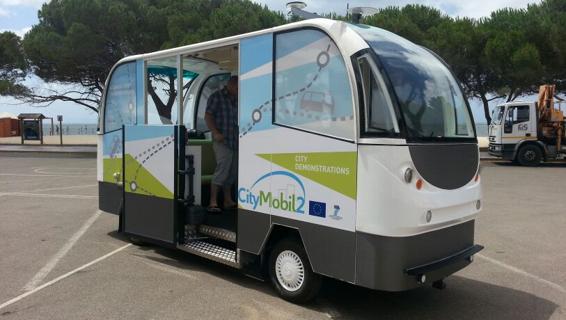A TORREGRANDE (ORISTANO) LA PRIMA CITTA’ EUROPEA COL MINIBUS SENZA AUTISTAIN TORREGRANDE (ORISTANO) AND ‘THE FIRST TOWN’ WITH EUROPEAN MINIBUS DRIVER WITHOUT
 Oristano diventa la prima città europea a ospitare un sistema di trasporto pubblico con mezzi senza autista e completamente automatizzati. Il mezzo si chiama RobuCity, è prodotto in Francia, dove è stato presentato nel giugno scorso.
Oristano diventa la prima città europea a ospitare un sistema di trasporto pubblico con mezzi senza autista e completamente automatizzati. Il mezzo si chiama RobuCity, è prodotto in Francia, dove è stato presentato nel giugno scorso.
Il servizio del bus-robot, che ha carattere sperimentale, partirà ufficialmente dal 14 luglio per proseguire poi fino alla fine del mese di agosto.
La sperimentazione fa parte del progetto CityMobil2 cofinanziato dalla Commissione Europea nell’ambito di un programma per la ricerca e l’innovazione e si svolgerà sul lungomare della borgata marina di Torregrande, dove due minibus elettrici da 12 posti senza autista andranno avanti e indietro per circa un chilometro e mezzo dividendo il percorso con pedoni e ciclisti.
Alla sperimentazione potranno partecipare gratuitamente tutti gli oristanesi e i turisti, previa registrazione. Obiettivi del progetto sono verificare le prestazioni tecniche dei sistemi di trasporto senza guidatore in un ambiente reale e il riscontro da parte degli utenti.
Le prossime tappe della sperimentazione saranno a Leon in Spagna, La Rochelle in Francia e Losanna in Svizzera. A Milano i minibus senza autista RubuCity saranno protagonisti dell’Expò 2015.
Partner del progetto, coordinato dall’Università La Sapienza di Roma, sono il Comune di Oristano, l’Arst, la società di consulenza Mlab di Cagliari e la società francese Robosoft, che ha realizzato i veicoli.
Il volante dei due bus automatici è affidato a un apparato Gps integrato che è in grado di rispettare al centimetro la traiettoria studiata dai tecnici. E tutto il sistema di sicurezza, quello che permetterà ai bus di fermarsi per evitare pericolosi incidenti, è legato a un scanner laser bidimensionale capace di rilevare qualunque anomalia sul percorso. «Se c’è un ostacolo il mezzo rallenta all’istante – sottolinea l’ingegnere – Sul lungomare di Torregrande, dove c’è tanta gente che va e viene, i bus viaggiano ad appena dodici chilometri orari, ma in un normale percorso cittadino sono in grado spostarsi alla velocità di quaranta all’ora».
L’alimentazione è assicurata da alcune batterie ricaricabili collegate anche a un software che tiene sempre sotto controllo i consumi. Quando la carica sta per esaurirsi la velocità si riduce e così il bus è in grado di tornare alla base senza il rischio di fermarsi a metà strada. Tutt’al più non riparte e alla fermata qualcuno attenderà invano.
 Oristano became the first European city to host a public transport system means no driver and fully automated. The medium is called RobuCity, is produced in France, where it was presented last June.
Oristano became the first European city to host a public transport system means no driver and fully automated. The medium is called RobuCity, is produced in France, where it was presented last June.
The service of the bus-robot, which has an experimental character, will officially start from July 14 to continue till the end of August.
The trial is part of the project CityMobil2 co-funded by the European Commission as part of a program for research and innovation and will take place on the promenade of the coastal village of Torre Grande, where two electric minibuses with 12 seats without a driver going back and forth for about a mile by dividing the path with pedestrians and cyclists.
The trial will be able to attend free of charge all of Oristano and visitors upon registration. Objectives of the project are to verify the technical performance of driverless transport systems in a real environment and the feedback from the users.
The next stages of the trial will be at Leon in Spain, La Rochelle in France and Lausanne in Switzerland. In Milan, the minibus driver without RubuCity Expo 2015 will be the protagonists.
Partners of the project, coordinated by the University La Sapienza of Rome, are the city of Oristano, Arst, the consulting firm Mlab of Cagliari and the French company Robosoft, which has made vehicles.
The steering wheel of the two buses is entrusted to an automatic apparatus integrated GPS that is able to adhere to the centimeter trajectory studied by technicians. And all of the security system, one that will allow the bus stop to avoid dangerous accidents, is linked to a two-dimensional laser scanner capable of detecting any anomaly on the path. “If there is an obstacle instantly slows down the middle – said the engineer – On the promenade of Torre Grande, where there are many people coming and going, the bus traveling at just twelve miles an hour, but in a normal city tour are able to move at a speed of forty per hour. “
The power supply is ensured by some rechargeable batteries also connected to software that keeps consumption under control. When the charge is low the speed is reduced and so the bus is able to return to the base without the risk of stopping half way. At most, does not restart and will wait in vain for someone to stop.
Leave a Comment
You must be logged in to post a comment.






